Opticks : GPU Optical Photon Simulation
http://simoncblyth.bitbucket.io/env/presentation/opticks_gpu_optical_photon_simulation_psroc.html (Jan 2016) http://simoncblyth.bitbucket.io/env/presentation/opticks_gpu_optical_photon_simulation.html (Jan 2016) http://simoncblyth.bitbucket.io/env/presentation/optical_photon_simulation_with_nvidia_optix.html (July 2015)
Executive Summary
Opticks integrates Geant4 simulations with state-of-the-art NVIDIA OptiX GPU ray tracing.
- DayaBay, JUNO can expect: Opticks > 1000x G4 (workstation GPUs)
Contents
- Neutrino Detection via Optical Photons
- Optical Photon Simulation Problem
- NVIDIA OptiX GPU Ray Tracing Framework
- Brief History of GPU Optical Photon Simulation Development
- Introducing Opticks : Recreating G4 Context on GPU
- Validating Opticks against Geant4
- Opticks Overview
Detecting Neutrinos via Optical Photons 1
Detecting Neutrinos via Optical Photons 2
Neutrino Detection via Optical Photons
Inverse beta decay: electron anti-neutrino captured on proton producing prompt positron and delayed neutron signals. Despite overburden cosmic muons remain important backgrounds.
-> large transparent target volumes coupled to Photomultiplier Tubes
Scintillator: DayaBay/JUNO, Double Chooz, RENO, KamLAND
Water Cerenkov: SNO, SuperK/HyperK, IceCube/PINGU, KM3NeT, Baikal-GVD
Detailed model of Optical Photon Propagation critical to detector design/use.
JPMT Before Contact 1
JPMT Before Contact 2
Optical Photon Simulation Problem
Cosmic muons can yield many millions of optical photons in Daya Bay (even more in JUNO). Optical photon propagation dominates Geant4 simulation time ~95% for Daya Bay.
Cosmic Muon Sample sizes severely limited by CPU time practicalities.
Hybrid Solution
External propagation possible as optical photons are isolated in simulation chain.
- produced by Cerenkov/Scintillation
- yield only PMT hits
JPMT Before Contact 3
Geant4/Opticks Interface
- collect "steps" in customized G4 Cerenkov/Scintillation processes
- massively parallel generation, propagation of optical photons costing no CPU memory
- return PMT hits to G4 collections
- subsequent electronics simulation unchanged
NVIDIA OptiX GPU Ray Tracing Framework
Ray Tracing ?
Pixels calculated by tracing rays from image plane into geometry, recursively doing reflection, refraction, shadow calculations.
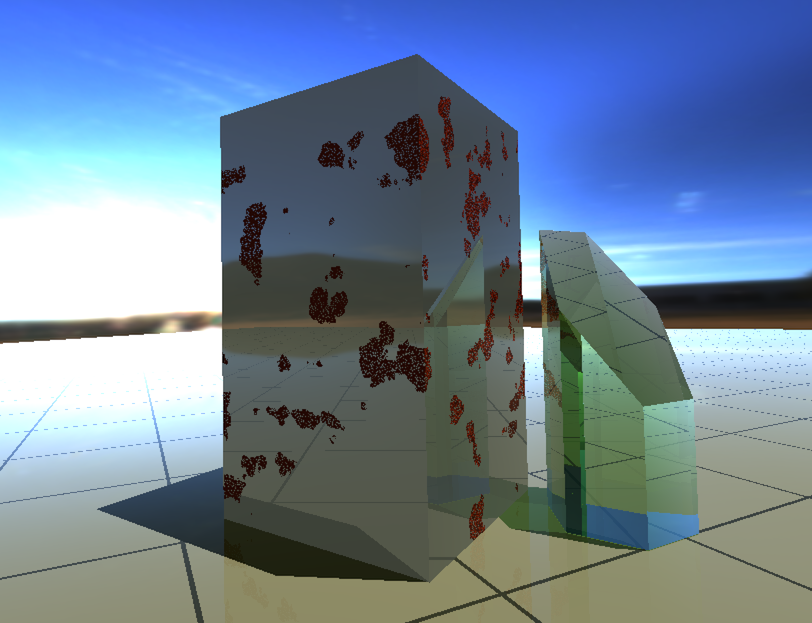
Ray Tracing more realistic (closer to physics) than rasterized projection
Apply Image Synthesis Tool to Photon Simulation
Same rate determining step : geometry intersection
OptiX Provides:
CUDA compiler optimized for Ray Tracing
- state-of-the-art accelerated intersection
- regular improvements, new GPU tuning
NVIDIA expertise on efficient GPU(s) usage
- persistent warps sized to fill machine
- load balancing between warps, GPUs
IHEP Performance Check
Used IHEP 4 GPU workstation to verify near linear performance scaling across multiple GPUs
https://developer.nvidia.com/optix
https://research.nvidia.com/publication/optix-general-purpose-ray-tracing-engine
Brief History of GPU Optical Photon Simulation Development
Hybrid Simulation
Combining G4 with external simulation requires "context" duplication
- geometry, materials, surfaces
- runtime bridging of event data
Ray Tracing demands translation:
- volumes -> surfaces
1704
- Newton published Opticks
2013(Aug-) [liberate geometry]
- Develop G4DAE geometry exporter that writes tesselated COLLADA 3D files, including all material and surface properties.
2014 [integrate geometry/event data with Chroma]
- Integrate G4DAE geometries with Chroma
- Connect event data via G4DAEChroma runtime bridge
- Port Cerenkov/Scintillation photon generation to GPU avoiding transport overhead
2015 [replace Chroma with Opticks]
- Develop Opticks based on the NVIDIA OptiX ray tracing framework
- Achieve match between Opticks and Geant4 for simple geometries
- Speedup factor of 200x with a mobile GPU, expected to exceed 1000x with multi-GPU workstations.
Introducing Opticks : Recreating G4 Context on GPU
Opticks ~15 C++ Pkgs
Organized by dependencies
- Recreates Geant4 context on GPU
- Optical simulation by OptiX programs
- Photon Indexing by Thrust
Interop between OpenGL/OptiX/Thrust/CUDA
- shared GPU buffers, efficient visualization
C++ code but NumPy analysis/debugging by using .npy serialization for all buffers
Externals:
- Boost + Asio-ZMQ, ZMQ
- CUDA 7.0, Thrust 1.8
- OptiX 3.8, OpenGL 4.1
- OpenMesh 4.1, ImGUI
Basis packages
- Opticks : definitions, configuration
- NPY : host array handling, persistency, analysis
- NumpyServer : network IO of NPY arrays
Geometry packages
- AssimpWrap : G4DAE geometry loading with Assimp fork
- GGeo : preparing geometry for GPU
- OpenMeshRap : mesh fixing
GPU library interface packages
- OpticksOp : high level GPU control
- OptiXRap : OptiX control
- ThrustRap : photon indexing
- CUDAWrap : persist cuRAND state
- OGLWrap : OpenGL visualization
Main packages
- GGeoView : visualization, Opticks main
- CFG4 : Geant4 10.2 comparison, separate main
Opticks Absolute Reflection compared to Fresnel expectation
Comparison of simulated absolute reflection of S and P polarized single events against expectation from Fresnel formula. Using uniform planar incident cyclindrically directed light.

Opticks Prism Deviation vs Incident angles for 10 wavelengths
Prism geometry and Snell's law at two refractions allows deviation angle vs incident angle to be predicted. Comparison of simulation results with expectations for 10 wavelengths using refractive index of Schott F2 Flint Glass.
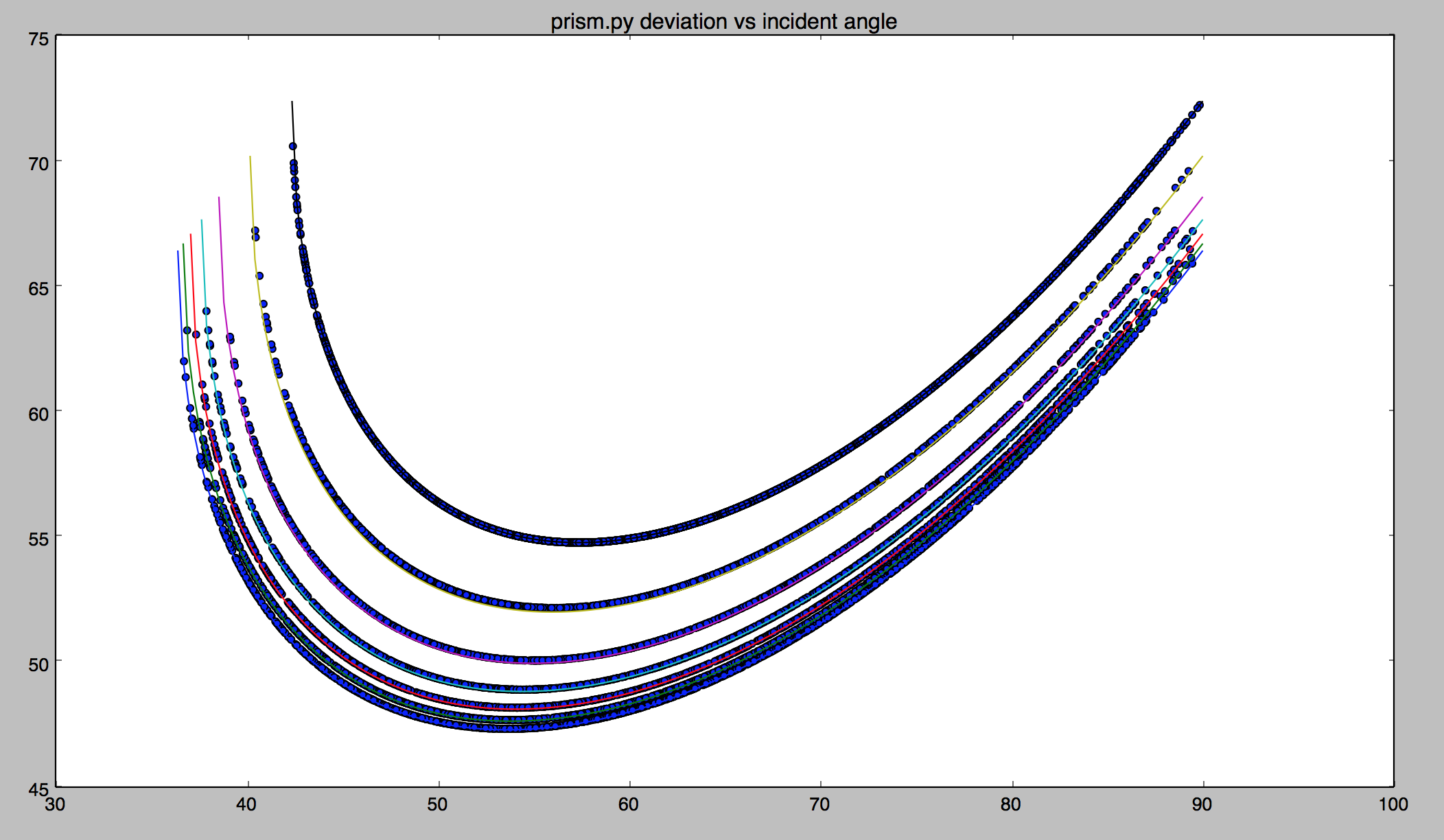
Validating Opticks against Geant4
CfG4 package
- G4 step recorder in Opticks event format
- load events into Opticks for visualization
Compare Opticks/Geant4 propagations with simple test geometries and light sources. For each test shape:
- OptiX: analytic intersection code
- OpenGL: tesselation for visualization
- Geant4: geometry construction code in CfG4 package
| Shape | OptiX | OpenGL | Geant4 |
|---|---|---|---|
| sphere | Y | Y | Y |
| box | needs debug | Y | Y |
| prism | Y | Y | |
| convex lens | Y | Y | |
| DayaBay PMT | Y | Y | needs port |
Multiple Rainbows from a Single Drop of Water
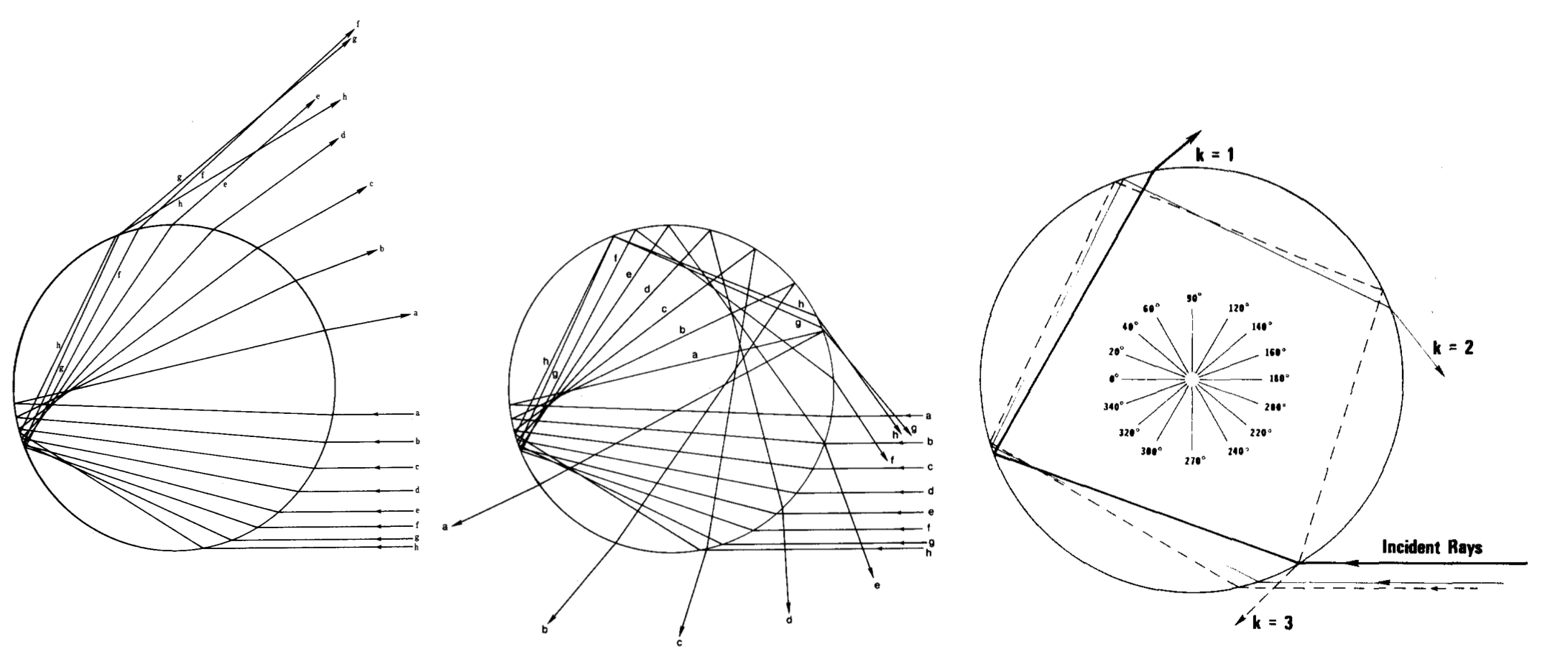
Caustic bunching at least deviation causes rainbow
- Primary bow, single reflection : ray f at bow angle
- Secondary bow, double reflection : ray g at bow angle
- Deviation angles 0:180 degrees hemisphere opposite to incident rays
Jearl D. Walker, 1975, Multiple rainbows from single drops of water and other liquids http://patarnott.com/atms749/pdf/MultipleRainbowsSingleDrops.pdf
Disc beam 1M Photons incident on Water Sphere (S-Pol)
Photons shown by lines with color representing polarization direction. S-Polarized (perpendicular to plane of incidence) intersection by disc radially directed polarization. Geodesic icosahedron tesselation just for OpenGL visualization, actual OptiX geometry is perfect sphere.
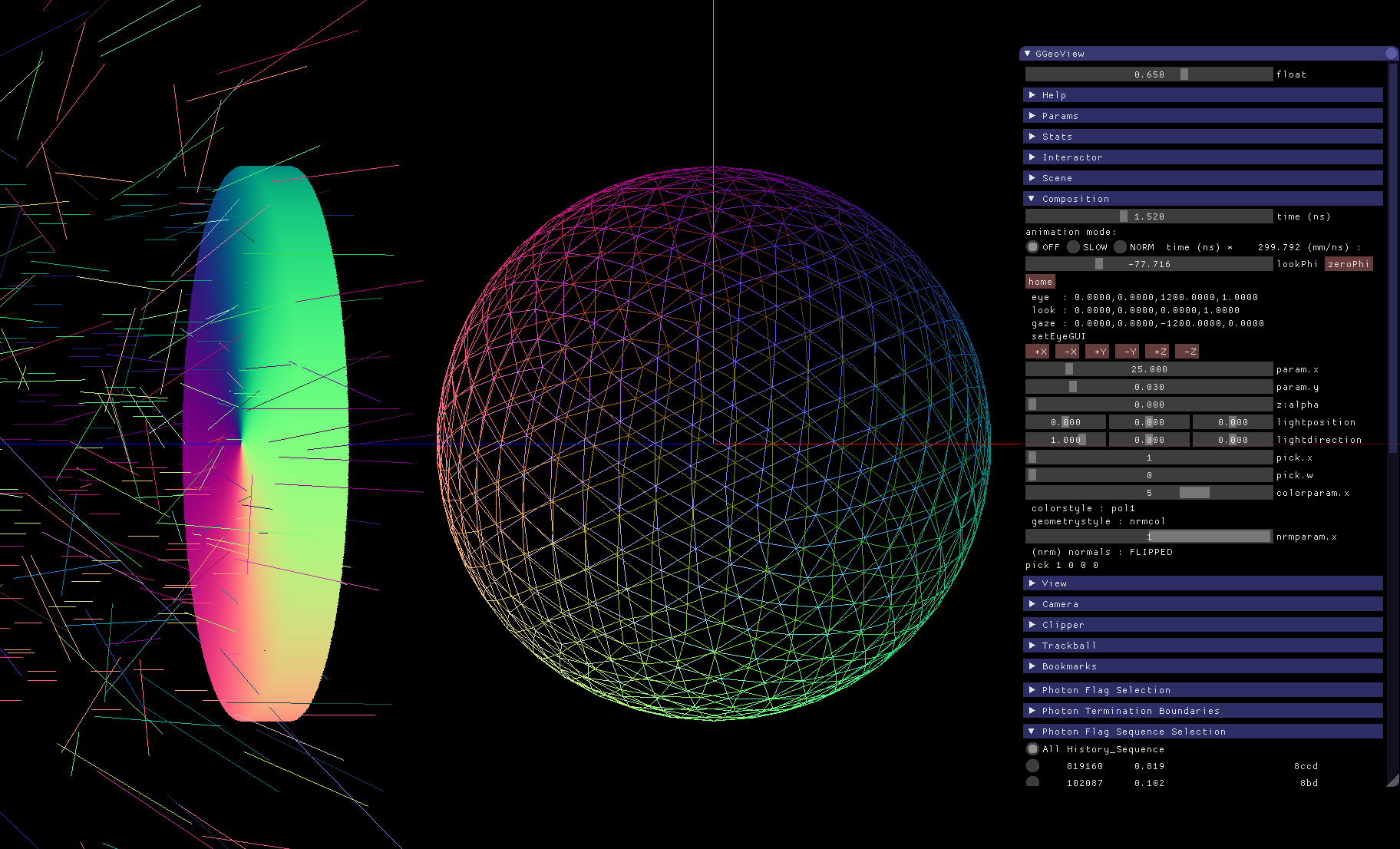
2ns later, Several Bows Apparent
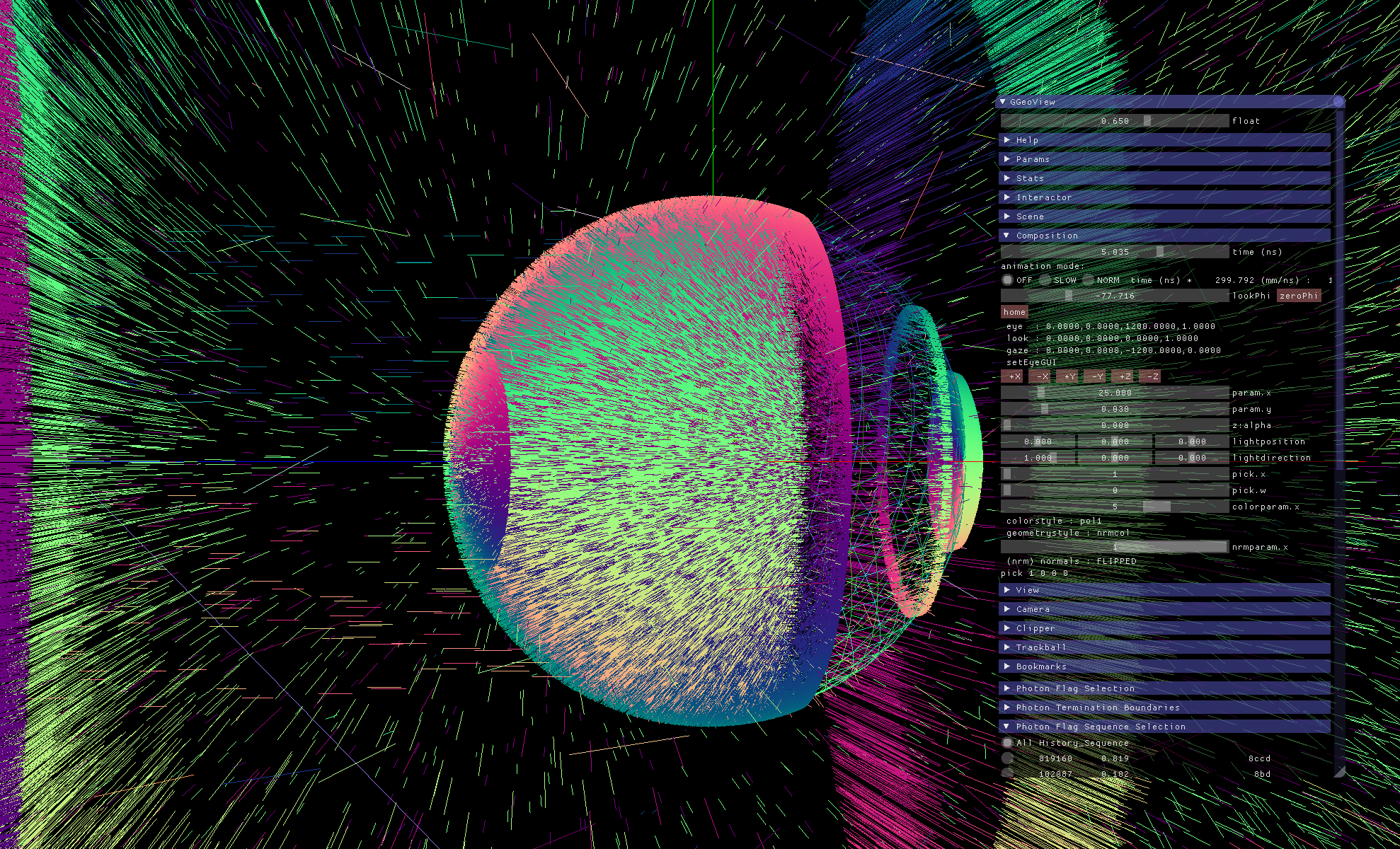
Rainbow deviation angles
Deviation angle distribution of all 3M photons. Photon wavelengths from Plankian 6500K blackbody spectrum (implemented with inverse CDF GPU texture lookup). Simulated "images" obtained from wavelength spectrum of each bin using CIEXYZ weighting functions converted into sRGB/D65 colorspace. The two images exposed for luminance (CIE-Y) of max bin of 1st and 2nd bows.
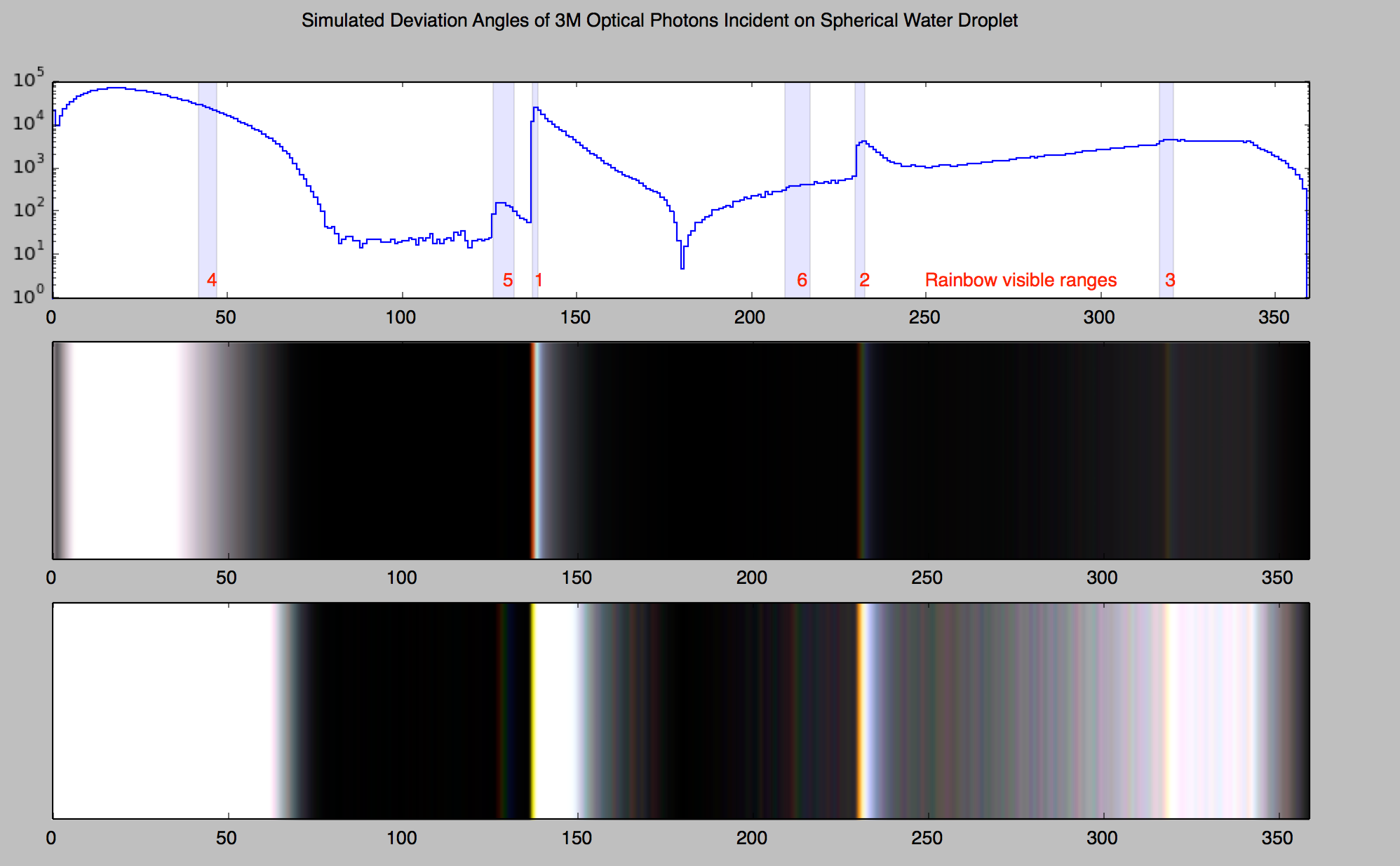
Rainbow Spectrum for 1st six bows
Spectra obtained by selecting photons by internal reflection counts. Colors obtained from spectra of each bin using CIEXYZ weighting functions converted into sRGB/D65 colorspace. Exposures by normalizing to bin with maximum luminance (CIE-Y) of each bow. White lines indicate geometric optics prediction of deviation angle ranges of the visible range 380-780nm. 180-360 degrees signifies exit on same side of droplet as incidence.
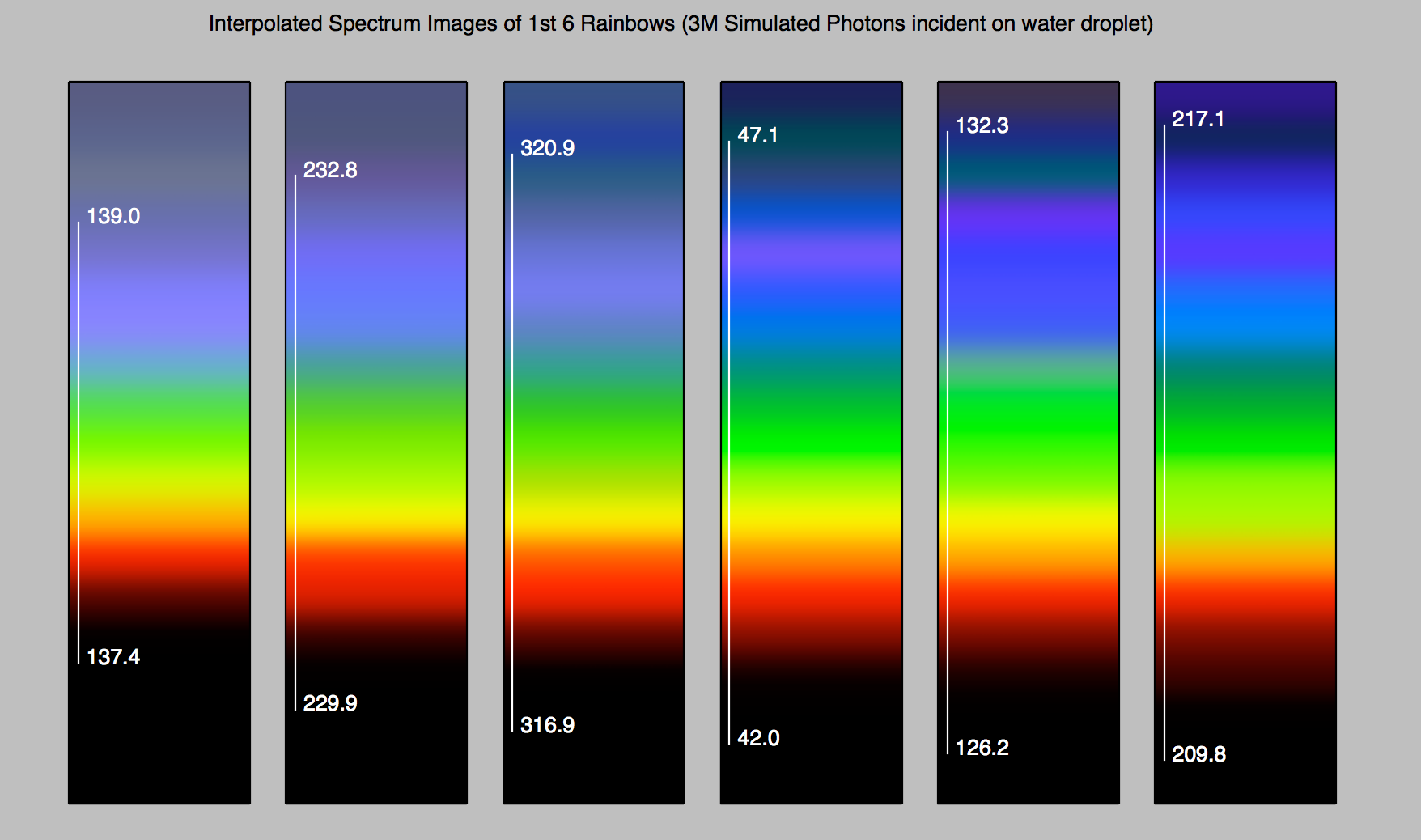
1M Rainbow S-Polarized, Comparison Opticks/Geant4
Deviation angle(degrees) of 1M parallel monochromatic photons in disc shaped beam incident on water sphere. Numbered bands are visible range expectations of first 11 rainbows. S-Polarized intersection (E field perpendicular to plane of incidence) arranged by directing polarization radially.
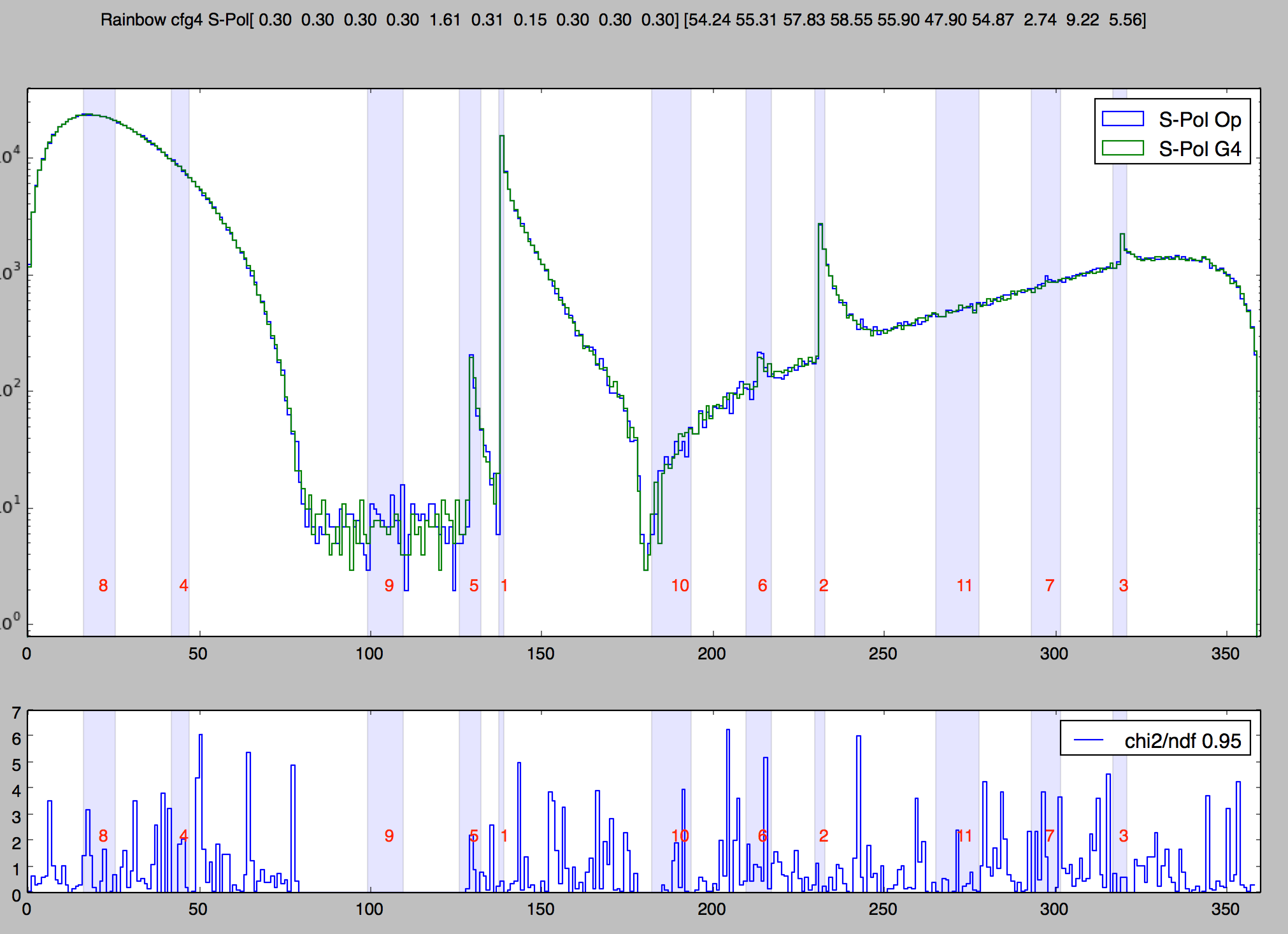
Performance Comparison Opticks/Geant4
Rainbow 1M S-Pol
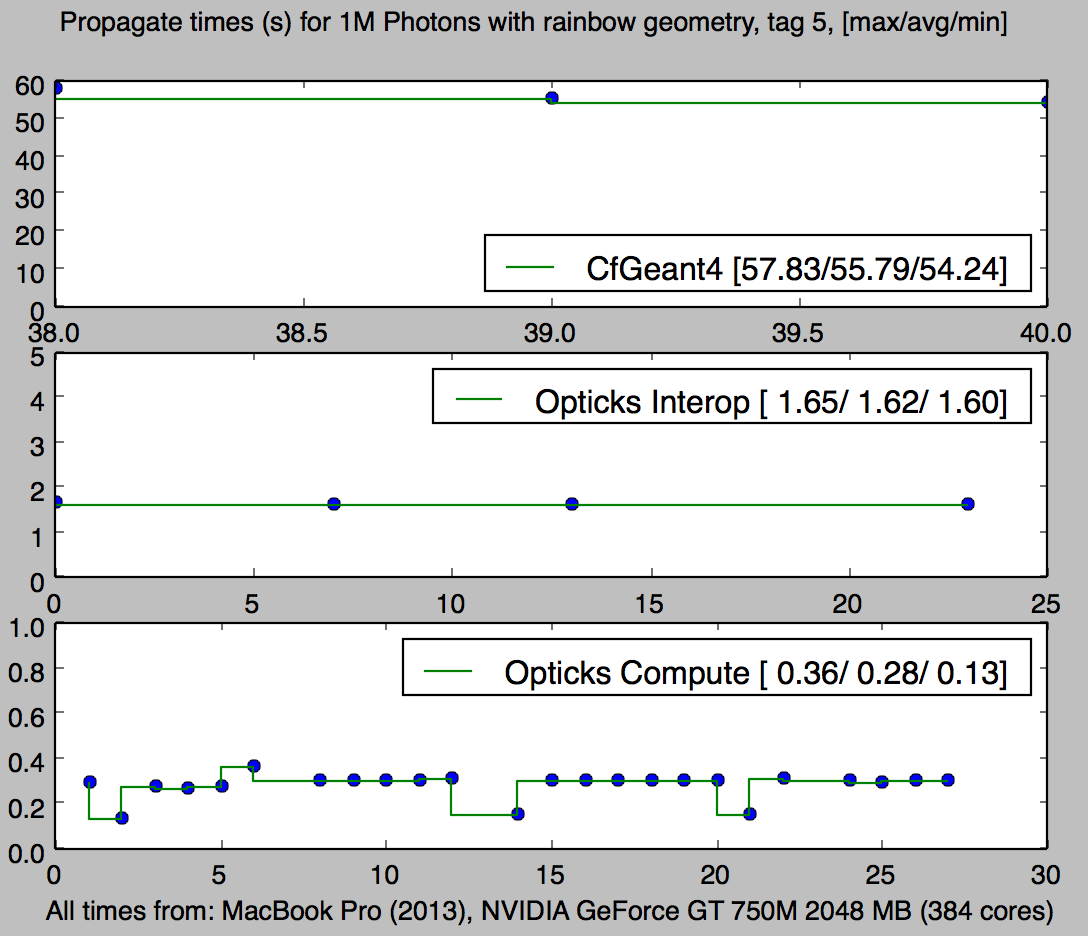
Average Propagate Time for 1M photons
MacBook Pro 2013, NVIDIA GeForce GT 750M 2GB (384 cores)
| Rainbow Test | Geant4 10.2 | Opticks Interop | Opticks Compute |
|---|---|---|---|
| 1M (S-Pol) | 56 s | 1.62 s | 0.28 s |
| 1M (P-Pol) | 58 s | 1.71 s | 0.25 s |
- Opticks ~200X Geant4 with 384 core GPU
- expect > 1000X with multi-GPU workstation
- photon propagation time --> zero (effectively)
Opticks Interop/Compute Modes
- Interop: uses visualizable OpenGL buffers
- Compute: uses OptiX buffers
- perfectly identical results, monitored by digest
- Compute (and G4) propagated events visualizable by loading into interop mode viewer
JPMT Inside Wide
Opticks Overview
- G4 integrated with GPU ray tracing
- validation against G4 started
- optical propagation time --> ~zero
- high performance visualization
JPMT After Contact
http://simoncblyth.bitbucket.io/env/graphics/ggeoview/jpmt-after-contact_half.png
JPMT Inside Outside
http://simoncblyth.bitbucket.io/env/graphics/ggeoview/jpmt-inside-outside_half.png
Photon History Selection
Only CK BT BT BT SA, three boundary transmits before surface absorption